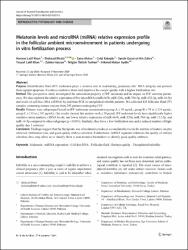| dc.contributor.author | Khan,Haroon Latif | |
| dc.contributor.author | Bhatti,Shahzad | |
| dc.contributor.author | Abbas,Sana | |
| dc.contributor.author | Kaloglu, Celal | |
| dc.contributor.author | Qurat-ul-Ain Zahra, Syeda | |
| dc.contributor.author | Khan, Yousaf Latif | |
| dc.contributor.author | Hassan, Zahira | |
| dc.contributor.author | Öztürk Turhan, Nilgün | |
| dc.contributor.author | Aydin, Hikmet Hakan | |
| dc.date.accessioned | 2022-05-16T09:46:37Z | |
| dc.date.available | 2022-05-16T09:46:37Z | |
| dc.date.issued | 2021 | tr |
| dc.identifier.uri | https://hdl.handle.net/20.500.12418/13134 | |
| dc.description.abstract | Abstract
Purpose
Intrafollicular fluid (IFF) melatonin plays a decisive role in maintaining granulosa cells’ DNA integrity and protects them against apoptosis. It reduces oxidative stress and improves the oocyte quality with a higher fertilization rate.
Method
This prospective study investigated the antioxidant property of IFF melatonin and its impact on IVF outcome parameters. We also explored the relative expression of five microRNAs (miR-663b, miR-320a, miR-766-3p, miR-132-3p, miR-16-5p) and levels of cell-free DNA (cfDNA) by real-time PCR in unexplained infertile patients. We collected 425 follicular fluid (FF) samples containing mature oocytes from 295 patients undergoing IVF.
Results
Patients were subgrouped based on IFF melatonin concentration (group A ≤ 30 pg/mL, group B > 70 to ≤ 110 pg/mL, group C > 111 to ≤ 385 pg/mL). Our results showed that patients with ≤ 30 pg/mL IFF melatonin levels have significantly higher oxidative stress markers, cfDNA levels, and lower relative expression of miR-663b, miR-320a, miR-766-3p, miR-132-3p, and miR-16-5p compared to other subgroups (p < 0.001). Similarly, they have a low fertilization rate and a reduced number of high-quality day 3 embryos.
Conclusion
Findings suggest that the therapeutic use of melatonin produces a considerable rise in the number of mature oocytes retrieved, fertilization rate, and good-quality embryo selection. Furthermore, miRNA signature enhances the quality of embryo selection, thus, may allow us to classify them as non-invasive biomarkers to identify good-quality embryos. | tr |
| dc.language.iso | eng | tr |
| dc.relation.isversionof | 10.1007/s10815-020-02010-2 | tr |
| dc.rights | info:eu-repo/semantics/openAccess | tr |
| dc.subject | Melatonin | tr |
| dc.subject | miRNA expression | tr |
| dc.subject | Cell-free DNA | tr |
| dc.subject | Follicular fluid | tr |
| dc.subject | Embryo quality | tr |
| dc.subject | Unexplained infertility | tr |
| dc.title | Melatonin levels and microRNA (miRNA) relative expression profile in the follicular ambient microenvironment in patients undergoing in vitro fertilization process | tr |
| dc.type | article | tr |
| dc.relation.journal | Journal of Assisted Reproduction and Genetics | tr |
| dc.contributor.department | Tıp Fakültesi | tr |
| dc.contributor.authorID | 0000-0002-9428-5259 | tr |
| dc.identifier.volume | 38 | tr |
| dc.identifier.endpage | 459 | tr |
| dc.identifier.startpage | 443 | tr |
| dc.relation.publicationcategory | Uluslararası Editör Denetimli Dergide Makale | tr |















